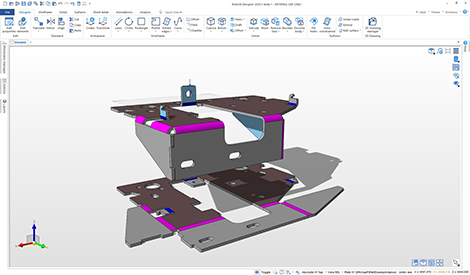
Hexagon is billing its new Radan Designer software as a pivotal part of Radan’s functionality as the “ultimate solution for taking geometry through to manufacture”, even allowing full CAD assemblies to be imported for accurate cost quoting.
Used for preparing parts for bending, nesting and cutting, in workflows such as model design to part repair and modification, the new module contains a material library and several calculation methods to create the correct unfolded shape.
“Unfolding parameters such as bend allowances, can be controlled independently of the geometry, leading to more accurate flat blanks, more accurate folding, and ultimately, to a higher quality product,” explained product manager Olaf Körner.
He added that the new release delivers a more ‘flexible, fluent approach’, by enabling parts for additional jobs to continuously go on to the nest, which he says leads to improved machine and sheet utilisation.
“It means manufacturers can react to changing priorities. They can simply add more parts without having to clean up the workspace, so the nesting process, and production, keeps going with no interruption.”
Any multi-body or assembly files can be added into the software’s Radquote tools, meaning that a complete Solidworks assembly can be dropped in, which then unfolds all the sheet metal parts and calculates cycle times, to prepare an accurate quote.
A new Common Grid Cutting algorithm has been introduced to optimise sequences and perform the common line cuts first, and then once around the perimeter, instead of beginning with outside cuts. “It’s a much more effective way of working, both for pairs of parts and larger grids. The risk of tipping is considerably reduced, and the heat build-up is more predictable,” said Körner.
Four items of new functionality have been added to the Radtube module: it can Radtube can now use CSV files that specify the name of the product, quantity, and other parameters, negating the need to key them in again. Colour coding of specific parts ensures quick identification all the way through the process, so the operator doesn’t have to rely on recognising it by shape or size.
The other two items follow on from that and are also linked to identification: improved reporting so that documentation going to the shop floor includes the colour coordination, and introducing a simple line font, instead of a more intricate TrueType font for text marking and imprinting parts.
Körner highlights that Radan’s roadmap continues to bring all aspects of the software closer together. “For example, 2D nesting and tube nesting have very similar properties; Radquote is becoming as popular in quoting for tube contracts as for sheet metal; and the endless nesting workflow can be used just as effectively for Radtube as flat blanks. It reduces the time required to prepare a quote to around a fifth of what it used to be.
“While there are many different things to consider, the final result is driving the manufacturing processes in the most efficient and profitable way.”






